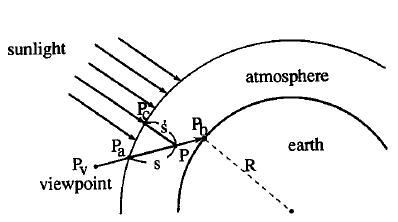Update
I am editing and posting this question in a different way; this time from the point of view of Nishita paper.
Sunlight gets scattered at P and attenuated before reaching Pv. Therefore intensity reaching Pv coming from P can be obtained by multiplying the attenuation by intensity at P:
The intensity reaching Pv therefore can be obtained by integrating light due to air molecules along the ray segment PaPb:
Where
If I am to solve this integral by Monte Carlo method and without ray marching approach, What would be the estimator and what are the good choices for pdf and sampling method?
Thanks.
I am trying to implement the concept of distributed ray tracing on Rayleigh scatterting to render sky a bit more realistic. The code I use is borrowed from this website. It takes 16 samples along the ray and 8 samples for sunlight. This works fine and I was able to generate this image using only 1 sample per pixel(not sure why the sun is so small, any idea?):
I then tried to use Monte Carlo to do this. 1 sample uniformly selected along the ray and 1 sample for sunlight. The only changes I did are on four lines:
line 7: uint32_t numSamples = 1; //16
line 8: uint32_t numSamplesLight = 1; //8
//used drand48() instead of 0.5
line 18: Vec3f samplePosition = orig + (tCurrent+
segmentLength * drand48()) * dir;
line 32: Vec3f samplePositionLight = samplePosition + (tCurrentLight +
segmentLengthLight * drand48) * sunDirection;
The pdf is 1/segmentLength and the sample is taken uniformly in this distance. Here is my implementation in c# code:
public override void Render(int pxlX, int pxlY, Random rand)
{
Vector estimatedColor = new Vector();
Ray ray = Scene.Camera.GenerateRay(pxlX + rand.NextDouble(), pxlY + rand.NextDouble(), rand.NextDouble(), rand.NextDouble());
ISect isect = Scene.Trace(ray);
if (ISect.IsNull(isect))
estimatedColor = Atmosph.ComputeIncidentLight(ray, rand);
else
estimatedColor = isect.Thing.Material.Emission +
ComputeRadiance(isect, rand, 0);
ImageFilm.AddToPixel(pxlX, pxlY, estimatedColor/numPixelSamples);
}
public Vector ComputeIncidentLight(Ray r, Random rand)
{
r.Start.Z += earthRadius;
ISect isect = earth.Intersect(r);
if (ISect.IsNull(isect)) return Vector.ZERO;
int numSamples = 1;
int numSamplesLight = 1;
double segmentLength = isect.Dist / numSamples;
double tCurrent = 0;
Vector sumR = Vector.ZERO;
Vector sumM = Vector.ZERO;// mie and rayleigh contribution
double opticalDepthR = 0, opticalDepthM = 0;
double mu = r.Dir.Dot(sunDirection); // mu in the paper which is the cosine of the angle between the sun direction and the ray direction
double phaseR = 3d / (16d * Math.PI) * (1 + mu * mu);
double g = 0.76f;
double phaseM = 3d / (8d * Math.PI) * ((1d - g * g) * (1d + mu * mu)) / ((2d + g * g) * Math.Pow(1d + g * g - 2d * g * mu, 1.5d));
for (int i = 0; i < numSamples; ++i)
{
Vector samplePosition = r.Start + r.Dir * (tCurrent + segmentLength * rand.NextDouble());
double height = samplePosition.Length() - earthRadius;
// compute optical depth for light
double hr = Math.Exp(-height / Hr) * segmentLength;
double hm = Math.Exp(-height / Hm) * segmentLength;
opticalDepthR += hr;
opticalDepthM += hm;
// light optical depth
ISect isectSun = earth.Intersect(new Ray(samplePosition, sunDirection));
double segmentLengthLight = isectSun.Dist/ numSamplesLight, tCurrentLight = 0;
double opticalDepthLightR = 0, opticalDepthLightM = 0;
int j;
for (j = 0; j < numSamplesLight; ++j)
{
Vector samplePositionLight = samplePosition + sunDirection * (tCurrentLight + segmentLengthLight * rand.NextDouble());
double heightLight = samplePositionLight.Length() - earthRadius;
if (heightLight < 0) break;
opticalDepthLightR += Math.Exp(-heightLight / Hr) * segmentLengthLight;
opticalDepthLightM += Math.Exp(-heightLight / Hm) * segmentLengthLight;
tCurrentLight += segmentLengthLight;
}
if (j == numSamplesLight)
{
Vector tau = betaR * (opticalDepthR + opticalDepthLightR) + betaM * 1.1f * (opticalDepthM + opticalDepthLightM);
Vector attenuation = new Vector(Math.Exp(-tau.X), Math.Exp(-tau.Y), Math.Exp(-tau.Z));
sumR += attenuation * hr;
sumM += attenuation * hm;
}
tCurrent += segmentLength;
}
// We use a magic number here for the intensity of the sun (20). We will make it more
// scientific in a future revision of this lesson/code
return (sumR * betaR * phaseR + sumM * betaM * phaseM) * sunIrradiance;
}
The below image rendered with 400 samples per pixel, however is different from the above:
Could anyone shed some light where I've got it wrong? Thanks,





